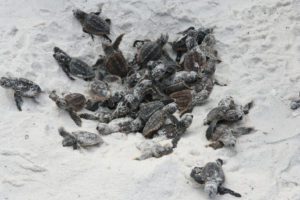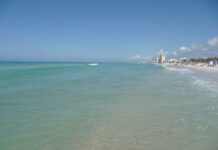Temporada de incubación de tortugas marinas en Pensacola Beach: Ayudarlos a prosperar
PENSACOLA BEACH, Fla.—La temporada de incubación de tortugas marinas está en pleno desarrollo en Pensacola Beach por lo que la Autoridad de la Isla Santa Rosa (SRIA) desea recordar a todos los residentes y visitantes de la isla cómo ayudar a las tortugas marinas con la menor interferencia posible.
Cada primavera, las tortugas marinas regresan a la playa de Pensacola por la noche, la misma playa en la que nacieron, para poner sus huevos. A partir de mayo, la toruga boba, tortuga verde, tortuga lora y, en raras ocasiones, tortugas baula, eligen Pensacola Beach para anidar.
Alrededor de 45 a 60 días después de que una madre tortuga marina arrastra su pesado cuerpo a nuestra orilla por la noche, cava un hoyo en la arena con sus aletas, y pone sus huevos – sus bebés están listos para nacer. La temporada de cría se extiende hasta finales de octubre en Pensacola Beach, con la altura de la eclosión generalmente en agosto y septiembre.
Casi todas las especies de tortugas marinas están clasificadas como en peligro de extinción, y algunas, como la tortuga lora, están en peligro crítico. Las tortugas marinas se enfrentan a muchos obstáculos cuando abandonan sus nidos, como mapaches, cangrejos, pájaros y peces. Las crías de tortugas marinas también usan la luz de la luna para guiarse al agua, pero pueden distraerse con las luces brillantes de las casas, condominios y negocios frente a la playa.
Sólo 1 de cada 1000 crías sobrevivirán hasta la edad adulta. Es por eso que es tan importante ser siempre respetuoso y considerado con las tortugas marinas y las crías anidadoras para garantizar que las futuras generaciones puedan disfrutarlas también.
Aquí hay algunos consejos útiles:
LIMPIEZA: Quite todas las tiendas de campaña, toldos, muebles, juguetes y otros obstáculos de la playa todas las noches.
PISO PLANO: Rellene los agujeros grandes, derribe los castillos de arena y otros obstáculos para dejar la playa plana para anidar tortugas marinas.
OSCURO: al caminar por la playa de noche durante la temporada de tortugas, recuerde usar una linterna roja. Las tortugas marinas y las crías son menos propensas a ser atraídas y desorientadas por la luz roja. Nunca toque ni hostigue a una tortuga marina anidando o crías de un bebé cuando salen de su nido. Mire en silencio desde la distancia y nunca encienda luces ni utilice fotografías con flash, lo que podría desorientarlas.
Si ve una tortuga marina o un polluelo enfermo, lesionado, en peligro o muerto, llame a la línea directa de 24 horas de la Comisión de Conservación de Pesca y Vida Silvestre de la Florida al 888-404-3922.
Estas sencillas medidas ayudarán a que estas especies en peligro tengan éxito, por lo que podemos seguir disfrutando de verlas nadar en nuestras aguas y en nuestras futuras generaciones costeras.
Sea Turtle Hatching Season on Pensacola Beach: Help Them Thrive
 PENSACOLA BEACH, Fla. — Sea turtle hatching season is in full swing on Pensacola Beach so the Santa Rosa Island Authority (SRIA) would like to remind all residents and visitors to the island how to help sea turtle with as little interference as possible.
PENSACOLA BEACH, Fla. — Sea turtle hatching season is in full swing on Pensacola Beach so the Santa Rosa Island Authority (SRIA) would like to remind all residents and visitors to the island how to help sea turtle with as little interference as possible.
Every spring, mother sea turtles return to Pensacola Beach at night, the same beach on which they were born, to lay their eggs. Beginning in May, Loggerhead, Green, Kemp’s Ridley, and on rare occasions, Leatherback sea turtles, choose Pensacola Beach for nesting.
About 45 to 60 days after a mother sea turtle hauls her heavy body onto our shore at night, digs a hole in the sand with her flippers, and lays her eggs – her babies are ready to hatch. Hatchling season runs through the end of October on Pensacola Beach, with the height of hatching usually in August and September.
Nearly all species of sea turtle are classified as endangered, and some, like the Kemp’s Ridley, are critically endangered. Baby sea turtles face many obstacles when first leaving their nests — such as raccoons, crabs, birds and fish. Sea turtle hatchlings also use the light of the moon to guide themselves to the water but can get distracted by bright lights from beach homes, condos and businesses facing the beach.
Only 1 in 1,000 hatchlings will survive to adulthood. That’s why it’s so important to always be respectful and considerate of nesting sea turtles and hatchlings to ensure that future generations get to enjoy them too.
Here are some helpful tips:
CLEAN: Remove all tents, canopies, furniture, toys and other obstacles from the beach every night.
FLAT: Fill in large holes, knock down sand castles and other obstacles to leave the beach flat for nesting sea turtles.
DARK: When walking the beach at night during turtle season, remember to use a red flashlight. Sea turtles and hatchlings are less likely to be attracted and disoriented by red lighting. Never touch or harass a nesting sea turtle or baby hatchlings as they leave their nest. Watch quietly from a distance and never shine lights or use flash photography, which could disorient them.
If you see a sea turtle or hatchling that is sick, injured, in distress or deceased, please call the Florida Fish and Wildlife Conservation Commission 24-hour hotline at 888-404-3922.
These simple measures will help this endangered species succeed, so we can continue to enjoy seeing them swim in our waters and on our shore generations to come.

















